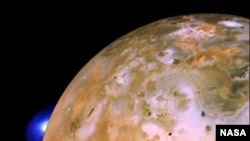Waves of lava flow inside the largest volcano crater on Jupiter’s fourth biggest moon, Loki.
Researchers at the University of California Berkeley were able to take advantage of a celestial alignment between Loki and another moon, Europa, to make the discovery.
Loki, which is the most volcanic body in the solar system, has over 400 active volcanoes, and Loki Patera is that moon's largest crater. Loki is named after the Norse god, and patera means a bowl-shaped volcanic crater.
In 2015, when Europa passed in front of the moon Io, it cast a shadow, allowing researchers to measure the ultraviolet radiation. That observation revealed a large temperature contrast inside the Loki Patera crater, which measures about 204 kilometers across. It has an area of 21,500 square kilometers, which is larger than Lake Ontario.
That, researchers say, suggests “the lava had overturned in two waves that swept from west to east at about a kilometer per day.”
"If Loki Patera is a sea of lava, it encompasses an area more than a million times that of a typical lava lake on Earth," said lead study author Katherine de Kleer, grad student at the University of California, Berkeley. "In this scenario, portions of cool crust sink, exposing the incandescent magma underneath and causing a brightening in the infrared."
Loki Patera’s crater is “shaped like a donut,” and the observations showed the two waves on either side of the hole. They believe the waves did not form simultaneously.
"The velocity of overturn is also different on the two sides of the island, which may have something to do with the composition of the magma or the amount of dissolved gas in bubbles in the magma," de Kleer said. "There must be differences in the magma supply to the two halves of the Patera, and whatever is triggering the start of overturn manages to trigger both halves at nearly the same time but not exactly. These results give us a glimpse into the complex plumbing system under Loki Patera."
The paper was published this week in the journal Nature.








